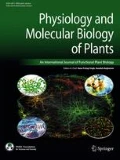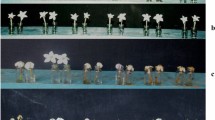Abstract
The present investigation primarily focussed on evaluating the efficacy of exogenous proline on the flower longevity of Dianthus chinensis L. Floral buds were harvested at the paint brush stage (i.e., a day prior to anthesis) and divided into 6 sets, with one set of buds (i.e., control) held in distilled water and rest of the 5 sets were supplemented with various concentrations of proline, viz., 10 mM, 20 mM, 30 mM, 40 mM and 50 mM. The application of proline at 40 mM concentration proved out to be most effective in improving the longevity of the flowers by about 4 days as compared to the control. The ameliorated longevity coincided with enhanced floral diameter, fresh mass, dry mass and water content. The flowers with delayed senescence also maintained higher soluble proteins, sugars and phenols. The results suggest that exogenous proline effectively alleviates oxidative stress in the petal tissue, as evident by a relatively lower maloendialdehyde content, which is manifested in the form of reduced lipid peroxidation (LPO). Reduced LPO was commensurate with increased membrane stability, quantified by membrane stability index. Moreover, the flowers with improved longevity exhibited a decline in lipoxygenase activity and significant augmentation of antioxidant enzymes superoxide dismutase, catalase and ascorbate peroxidase.




Similar content being viewed by others
References
Abdelaal KAA, Attia KA, Alamery SF, El-Afry MM, Ghazy AI, Tantawy DS, Al-Doss AA, El-Shawy ESE, Abu-Elsaoud AM, Hafez YM (2020) Exogenous application of proline and salicylic acid can mitigate the injurious impacts of drought stress on barley plants associated with physiological and histological characters. Sustain 12:1736
Aebi H (1984) Catalase in Vitro. Meth Enzymol 105:121–126
Ahmad SS, Tahir I (2016a) How and why of flower senescence: understanding from models to ornamentals. Indian J Plant Physiol 21:446–456
Ahmad SS, Tahir I (2016b) Increased oxidative stress, lipid peroxidation and protein degradation trigger senescence in Iris versicolor L. flowers. Physiol Mol Biol Plants 22:507–514
Ahmad SS, Tahir I (2017) Regulatory role of phenols in flower development and senescence in the genus Iris. Indian J Plant Physiol 22:135–140
Ahmed CB, Magdich S, Rouina BB, Sensoy S, Boukhris M, Abdullah FB (2011) Exogenous proline effects on water relations ions contents in leaves and roots of young olive. Amino Acids 40:565–573
AlKahtani MD, Hafez YM, Attia K, Rashwan E, Husnain LA, AlGwaiz HI, Abdelaal KA (2021) Evaluation of silicon and proline application on the oxidative machinery in drought-stressed sugar beet. Antioxid 10:398
Arora A, Sairam RK, Srivastava GC (2002) Oxidative stress and antioxidative system in plants. Curr Sci 25:1227–1238
Arrom L, Munné-Bosch S (2010) Tocopherol composition in flower organs of Lilium and its variations during natural and artificial senescence. Plant Sci 179:289–295
Aspinal D, Paleg G (1981) Proline accumulation: physiological aspects. In: Paleg LG, Aspinall D (eds) The Physiology and Biochemistry of Drought Resistance in Plants. Academic Press, Sydney, Australia, pp 280–295
Ataii D, Naderi R, Khandan-Mirkohi A (2015) Exogenous putrescine delays senescence of Lisianthus cut flowers. J Ornam Plants 5:167–174
Axerold B, Chesbrough TM, Laakso S (1981) Lipoxygenase from soybean. In: Lowenstein JM (ed) Meth Enzymol. Academic press, New York, pp 441–451
Bartoli CG, Simontacchi M, Montaldi E, Puntarulo S (1996) Oxidative stress, antioxidant capacity and ethylene production during ageing of cut carnation (Dianthus caryophyllus) petals. J Exp Bot 47:595–601
Chakrabarty D, Chatterjee J, Datta SK (2007) Oxidative stress and antioxidant activity as the basis of senescence in chrysanthemum florets. Plant Growth Regul 53:107–115
Chakrabarty D, Verma AK, Datta SK (2009) Oxidative stress and antioxidant activity as the basis of senescence in Hemerocallis (day lily) flowers. J Hortic 1:113–119
Chen GX, Asada K (1989) Ascorbate peroxidase in tea leaves: occurrence of two isozymes and the differences in their enzymatic and molecular properties. Plant Cell Physiol 30:987–998
Dar RA, Tahir I, Ahmad SS (2015) Is the biochemical mechanism of petal senescence similar within a genus? A case study of Dianthus. Hortic Environ Biotechnol 56:654–661
Dar MI, Naikoo MI, Rehman F, Naushin F, Khan FA (2016) Proline accumulation in plants: roles in stress tolerance and plant development. In: Osmolytes and plants acclimation to changing environment: emerging omics technologies. Springer, New Delhi p 155-166
Dhindsa RS, Plumb-Dhindsa PA, Thorpe TA (1981) Leaf senescence: correlated with increased levels of membrane permeability and lipid peroxidation, and decreased levels of superoxide dismutase and catalase. J Exp Bot 32:93–101
El-Shawa GM, Rashwan EM, Abdelaal KA (2020) Mitigating salt stress effects by exogenous application of proline and yeast extract on morpho-physiological, biochemical and anatomical characters of calendula plants. Sci J Flowers Ornam Plants 7:461–482
Forlani G, Trovato M, Funck D, Signorelli S (2019) Regulation of proline accumulation and its molecular and physiological functions in stress defence. In: Osmoprotectant-mediated abiotic stress tolerance in plants Springer, Cham p. 73–97
Fukuchi-Mizutani M, Ishiguro K, Nakayama T, Utsunomiya Y, Tanaka Y, Kusumi T, Ueda T (2000) Molecular and functional characterization of a rose lipoxygenase cDNA related to flower senescence. Plant Sci 160:129–137
Ghaffari H, Tadayon MR, Bahador M, Razmjoo J (2021) Investigation of the proline role in controlling traits related to sugar and root yield of sugar beet under water deficit conditions. Agric Water Manag 243:106448
Halliwell B (2006) Reactive species and antioxidants. Redox biology is a fundamental theme of aerobic life. Plant Physio 141:312–322
Hanif S, Saleem MF, Sarwar M, Irshad M, Shakoor A, Wahid MA, Khan HZ (2020) Biochemically triggered heat and drought stress tolerance in rice by proline application. J Plant Growth Regul. https://doi.org/10.1007/s00344-020-10095-3
Hasanuzzaman M, Alam M, Rahman A, Hasanuzzaman M, Nahar K, Fujita M (2014) Exogenous proline and glycine betaine mediated upregulation of antioxidant defense and glyoxalase systems provides better protection against salt-induced oxidative stress in two rice (Oryza sativa L.) varieties. Biomed Res Int 2014:17
Hayat S, Hayat Q, Alyemeni MN, Wani AS, Pichtel J, Ahmad A (2012) Role of proline under changing environments: a review. Plant Signal Behav 7:1456–1466
Heath RL, Packer L (1968) Photoperoxidation in isolated chloroplasts: I. Kinetics and stoichiometry of fatty acid peroxidation. Arch Biochem Biophys 125:189–198
Hossain Z, Mandal AKA, Datta SK, Biswas AK (2006) Decline in ascorbate peroxidase activity–A prerequisite factor for tepal senescence in gladiolus. J Plant Physiol 163:186–194
Kumar N, Pal M, Srivastava GC (2009) Proline metabolism in senescing rose petals (Rosa hybrida L. ‘First Red’). J Hortic Sci Biotechnol 84:536–540
Kumar N, Pal M, Singh A, SaiRam RK, Srivastava GC (2010) Exogenous proline alleviates oxidative stress and increase vase life in rose (Rosa hybrida L. ‘Grand Gala’). Sci Hortic 127:79–85
Kumar V, Khare T, Srivastav A, Surekha C, Shriram V, Wani SH (2019) Oxidative stress and leaf senescence: important insights. In: Senescence Signalling and Control in Plants Academic Press p. 139–163
Kwok D, Shetty K (1998) Effects of proline and proline analogs on total phenolic and rosmarinic acid levels in shoot clones of thyme (Thymus vulgaris L.). J Food Biochem 22:37–51
Lowry OH, Rosebrough NJ, Farr AL, Randall RJ (1951) Protein measurement with the folin phenol reagent. J Biol Chem 193:265–275
Mattioli R, Costantino P, Trovato M (2009) Proline accumulation in plants: not only stress. Plant Signal Behav 4:1016–1018
Mishra S, Dubey RS (2006) Inhibition of ribonuclease and protease activities in arsenic exposed rice seedlings: role of proline as enzyme protectant. J Plant Physiol 163:927–936
Mohammadrezakhani S, Hajilou J, Rezanejad F, Zaare-Nahandi F (2019) Assessment of exogenous application of proline on antioxidant compounds in three Citrus species under low temperature stress. J Plant Interact 14:347–358
Moustakas M, Sperdouli I, Kouna T, Antonopoulou CI, Therios I (2011) Exogenous proline induces soluble sugar accumulation and alleviates drought stress effects on photosystem II functioning of Arabidopsis thaliana leaves. Plant Growth Regul 65:315–325
Nakhaie A, Habibi G, Vaziri A (2020) Exogenous proline enhances salt tolerance in acclimated Aloe vera by modulating photosystem II efficiency and antioxidant defense. S Afr J Bot. https://doi.org/10.1016/j.sajb.2020.06.005
Nelson N (1944) A photometric adaptation of the Somogyi method for the determination of glucose. J Biol Chem 153:375–380
Nisar S, Dar RA, Tahir I (2021) Salicylic acid retards senescence and makes flowers last longer in Nicotiana plumbaginifolia (Viv). Plant Physiol Rep 26:128–136
Ozden M, Demirel U, Kahraman A (2009) Effects of proline on antioxidant system in leaves of grapevine (Vitis vinifera L.) exposed to oxidative stress by H2O2. Sci Hortic 119:163–168
Peary JS, Prince TA (1990) Floral lipoxygenase: activity during senescence and inhibition by phenidone. J Am Soc Hortic 115:455–457
Rady Taha Mahdi nMRSAH (2016) Proline enhances growth, productivity and anatomy of two varieties of Lupinus termis L. grown under salt stress. S Afr J Bot 102:221–227
Rogers HJ (2012) Is there an important role for reactive oxygen species and redox regulation during floral senescence? Plant Cell Environ 35:217–233
Rogers H, Munné-Bosch S (2016) Production and scavenging of reactive oxygen species and redox signaling during leaf and flower senescence: similar but different. Plant Physiol 171:1560–1568
Rouet-Mayer MA, Bureau JM, Lauriere C (1992) Identification and characterization of lipoxygenase isoforms in senescing carnation petals. Plant Physiol 98:971–978
Rubinstein B (2000) Regulation of cell death in flower petals. In: Lam E, Fukuda H, Greenberg J (eds) Programmed Cell Death in Higher Plants. Springer, Dordrecht, pp 59–74
Saeed T, Hassan I, Abbasi NA, Jilani G (2016) Antioxidative activities and qualitative changes in gladiolus cut flowers in response to salicylic acid application. Sci Hortic 210:236–241
Sairam RK (1994) Effect of moisture-stress on physiological activities of two contrasting wheat genotypes. Indian J Exp Biol 32:594–594
Seleiman MF, Semida WM, Rady nM, Mohamed GF, Hemida KA, Alhammad BA, Shami A (2020) Sequential application of antioxidants rectifies ion imbalance and strengthens antioxidant systems in salt-stressed cucumber. Plants 9:1783
Shinde S, Villamor JG, Lin W, Sharma S, Verslues PE (2016) Proline coordination with fatty acid synthesis and redox metabolism of chloroplast and mitochondria. Plant Physiol 172:1074–1088
Swain T, Hillis WE (1959) The phenolic constituents of Prunus domestica. I.—The quantitative analysis of phenolic constituents. J Sci Food Agric 10:63–68
Szabados L, Savouré A (2010) Proline: a multifunctional amino acid. Trends Plant Sci 15:89–97
Trippi V, Paulin A (1984) The senescence of cut carnations: a phasic phenomenon. Physiol Plant 60:221–226
Wang C, Lü P, Zhong S, Chen H, Zhou B (2017) LcMCII-1 is involved in the ROS-dependent senescence of the rudimentary leaves of Litchi chinensis. Plant Cell Rep 36:89–102
Zhang Y, Guo WM, Chen SM, Han L, Li ZM (2007) The role of N-lauroylethanolamine in the regulation of senescence of cut carnations (Dianthus caryophyllus). J Plant Physiol 164:993–1001
Zimmermann P, Zentgraf U (2005) The correlation between oxidative stress and leaf senescence during plant development. Cell Mol Biol Lett 10:515
Zouari M, Hassena AB, Trabelsi L, Rouina BB, Decou R, Labrousse P (2019) Exogenous proline-mediated abiotic stress tolerance in plants: Possible mechanisms. Osmoprotectant-Mediated Abiotic Stress Tolerance in Plants. Springer, Cham, pp 99–121
Author information
Authors and Affiliations
Corresponding author
Additional information
Publisher's Note
Springer Nature remains neutral with regard to jurisdictional claims in published maps and institutional affiliations.
Rights and permissions
About this article
Cite this article
Parveen, S., Altaf, F., Farooq, S. et al. Is proline the quintessential sentinel of plants? A case study of postharvest flower senescence in Dianthus chinensis L.. Physiol Mol Biol Plants 27, 1597–1607 (2021). https://doi.org/10.1007/s12298-021-01028-9
Received:
Revised:
Accepted:
Published:
Issue Date:
DOI: https://doi.org/10.1007/s12298-021-01028-9




